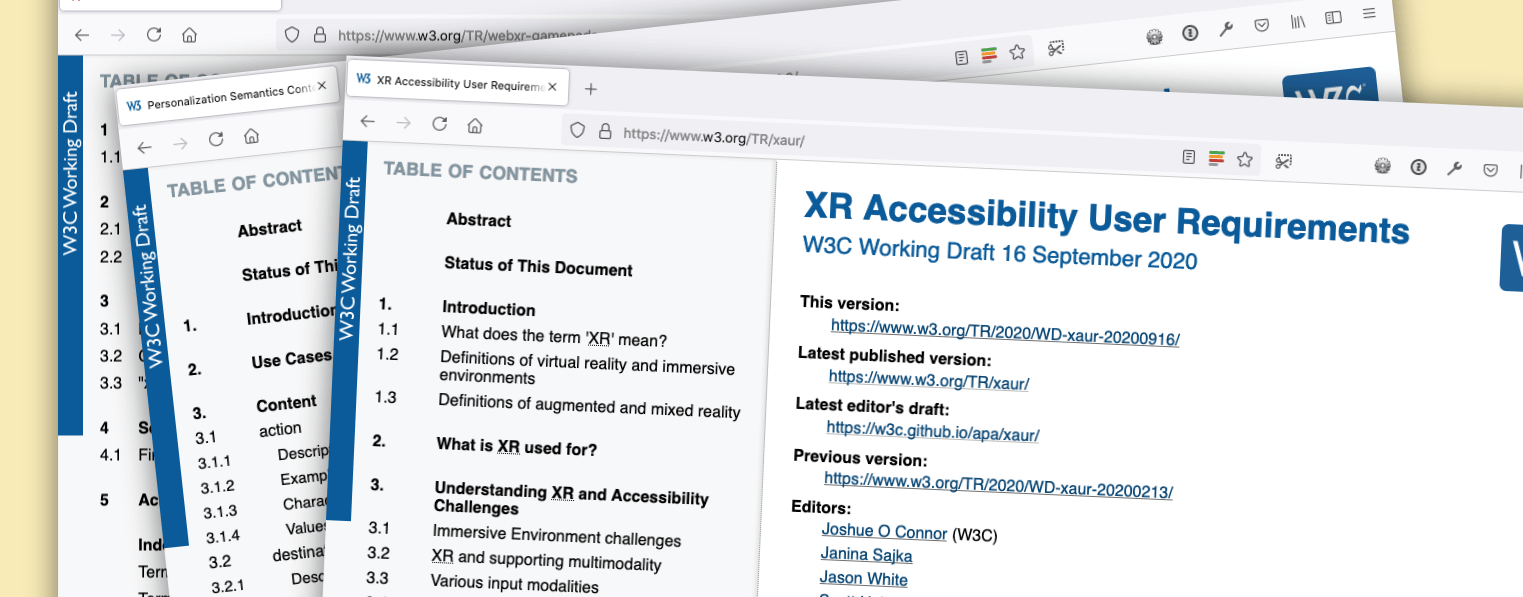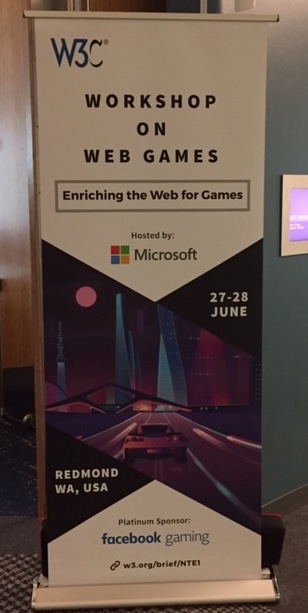
It’s already been over two years since I joined the W3C’s Accessible Platform Architectures (APA) Working Group. Time flying has pretty much been the nature of my involvement with APA, as it has been most welcoming and lots of fun.
This article describes the aspects of the group’s work in which I’ve been involved, some of the group’s wider projects, and how work gets done in W3C generally. I hope this will give you a flavour for what getting involved might be like. If you’re interested in contributing (which can be done in many ways, small and large, ad-hoc or over time), there’s some info on that below, too.
Here are some of the things we’ve been up to.
Accessible gaming

Back when I joined APA, W3C was planning a workshop on web games, and the organisers were keen to ensure that accessibility was prominently considered. With the support of the group, I authored a position paper, building on previous research projects and benefiting from some great feedback from industry experts in and outside the APA group.
Ours was one of two accessibility-focused papers accepted, and representing APA and TPGi at the web-games workshop was thoroughly enjoyable and educational. After the workshop, I continued technical work on web-game accessibility, and I was invited to write up those developments for 24 Accessibility.
Specification review
APA’s mission is to ensure that web specifications support people with disabilities. We achieve this by supporting the relevant working groups and reviewing documents. I performed accessibility reviews of the latest changes to the HTML standard (2019 HTML review; 2020 HTML review). This involved working with the WHATWG, which has also been welcoming and appreciative of contributions—and I’m looking forward to making more.
Day-to-day activities
We often review documents APA is working on as well as proposed W3C working-group charters to work out the type of contact and support that APA should offer to the new group. I’ve also been taking minutes in APA meetings, which are conducted through teleconferencing and IRC.
Here are the documents and charters I’ve co-reviewed:
- The WebXR Gamepads Module Level 1 (“XR” refers to virtual- or augmented-reality technologies)
- The proposed GPU for the Web Working Group charter
- The proposed first public working draft of the XR Accessibility User Requirements (XAUR)
Personalization
Recently I joined the Personalization Task Force within APA. This team is creating ways for web authors to convey the purpose and meaning of their content so that it can be adapted in many different ways. The current focus is on specific cognitive barriers and people who communicate with symbols, and the task force’s focus will be gradually expanded over time. This is very exciting stuff, because it could—will!—pave the way to a much more tailored web that meets users’ needs in far more dynamic ways than what’s currently possible, and I’m thrilled to be involved.
So far I have started making a basic prototype and test suite to help us anticipate some issues that people implementing the spec might face, so that we can make any needed tweaks or clarifications to preempt those issues.
The overall work is split into different modules, and the first of these is soon to reach its next stage of publication, where we seek wide review from the community before it’s finalised as version 1.0. So expect to hear more about this in the future, because your input is vital. You can find more links relating to personalisation in the next section.
I’m already learning a great deal from a very welcoming and constructive group of experts from several different industries and backgrounds. The work started several years back, and it comes out of a vast array of experience, both technical and in practice with users. We’re excited about the future, and we’re excited by what you’ll do with the opportunities offered by this approach.
How W3C works: in the open
I think two things about how W3C works are particularly cool.
Everything is developed, discussed, and decided in the open. (Some decisions, such as moving a document closer to being an official recommendation, are made by members only, but the process is conducted in the open.) Work-in-progress research and documents are public. There are regular (generally weekly) members-only calls to coordinate work, and their minutes are also public. Tools used include mailing lists; teleconferencing; IRC; custom database-backed web apps and GitHub. There are also yearly members-only face-to-face meetings and many workshops and other public events as needed (and the planning for those is done in the open, too).
Further, everything is done highly collaboratively. Contributions are welcome from everyone, and community involvement is highly sought after and encouraged. There are community interest groups, set up to be less formal, and galvanise interest on specific topics; these groups may either turn into working groups, or feed into their work. Within any particular group, people are keen to identify issues that need to be resolved, and to contribute what they can to help the group make progress.
Outside of the few areas in which I’ve been assisting, there are also many interesting things that the APA Working Group and its task forces have been working on during the time I have been involved. Here are some that come to mind:
- researching, raising awareness and making suggestions around CAPTCHA (in)accessibility;
- providing content authors with the ability to help text-to-speech systems pronounce things;
- researching and documenting XR-related activities (including the XR Accessibility User Requirements (XAUR) above);
- continuing work in the areas of cognitive accessibility and
- working with other groups on exploring exciting new infrastructure technologies and their potential accessibility use cases.
(…and that’s not even all!)
This in-the-open aspect was particularly well applied at W3C’s most recent annual meeting, TPAC (the W3C Technical Plenary / Advisory Committee). This event (historically in person) allows groups from across W3C to share updates, kick off collaborations, and get to know each other better.
The most recent such event was carried out online, so we seized the opportunity to involve as many people as possible. While some sessions were still for members only, the vast majority of the unconference-style breakout sessions were open to the public. There was also a great effort to ensure that these presentations and discussions were accessible and inclusive—all speakers were given training and support on running inclusive workshop sessions.
With the encouragement of APA, I ran a breakout on “Innovative adaptation, personalization and assistive technologies” (you can find the minutes and slides at that link), and I’m really grateful to everyone who attended for their input and the stimulating discussion that ensued. It was a virtual event, but there was a great community spirit. And I look forward to similar events in the future.
How a working group fits together
Much of a working group’s work is done by its task forces, each focused on a specific area of the group’s remit. When signing up, it’s normal to join a task force that’s in your area of interest, although it took me a while to join the Personalization Task Force due to the more ad-hoc nature of the projects on which I’ve been working, and everything being interesting! But as a working group member, you’re welcome to attend group meetings and follow—and join—other task forces, too.
Most importantly: a big thank you to Janina, Becky, Josh, Michael, Joanmarie, Jason, Lisa, Sharon, JF, Lionel, Charles, Ruoxi, and everyone else in the APA group for a very warm welcome and support while I was learning the ropes (which I am very much still doing). I’ve been lucky to meet a few of the group’s members in real life already, and I hope to be able to meet everyone in person in the not-too-distant future. Thanks also to Léonie Watson and Steve Faulkner for encouraging me to join, and to TPGi for supporting me and many of my work friends’ memberships and our adventures.
I’m lucky to work with some fab folk in my day job at TPGi and, likewise, I’m so chuffed to have the opportunity to work alongside such talented and motivated people on some really cool stuff as part of W3C. APA members work on many standards and software that a lot of us benefit from, which has been improving my own access to the digital world for many years, and I do hope and expect this is just the beginning.
Contributing
You can contribute feedback, such as by asking questions or reporting issues on specifications, through the specification’s or team’s GitHub repositories. The W3C’s GitHub page provides links to all of its repositories.
If this article has piqued your interest in following or contributing to APA’s or W3C’s work, please check out APA’s contribution page for more info. There are some general and public mailing lists as well as the GitHub repositories you can follow. Any input you can offer would be greatly appreciated!
TPGi at W3C
Several of us here at TPGi are involved with other cross-industry W3C groups; here are a few examples of projects underway:
- ARIA in HTML is a specification (soon to be finalised) that explains how to incorporate ARIA information into HTML pages in a standards-compliant way. It’s aimed at developers of validation tools, but it also contains helpful info on how the semantics of elements in certain situations would be conveyed to assistive technologies.
- Curricula on Web Accessibility is a project to create specifications to support teaching accessibility to different roles. The output is resources to help people create or evaluate courses, as opposed to the teaching materials themselves. The project recently released its Developer Modules outlines, and it has now started work on its Designer Module outline.
- We are active in the Accessibility Guidelines Working Group and recently contributed to the wide review of the upcoming 2.2 revision of the Web Content Accessibility Guidelines (WCAG).
Most importantly, though, anyone can contribute issue reports and suggestions to W3C specifications through the W3C GitHub repositories or the various public mailing lists. And these are the most common way we do that too, so please do send any feedback you can!
